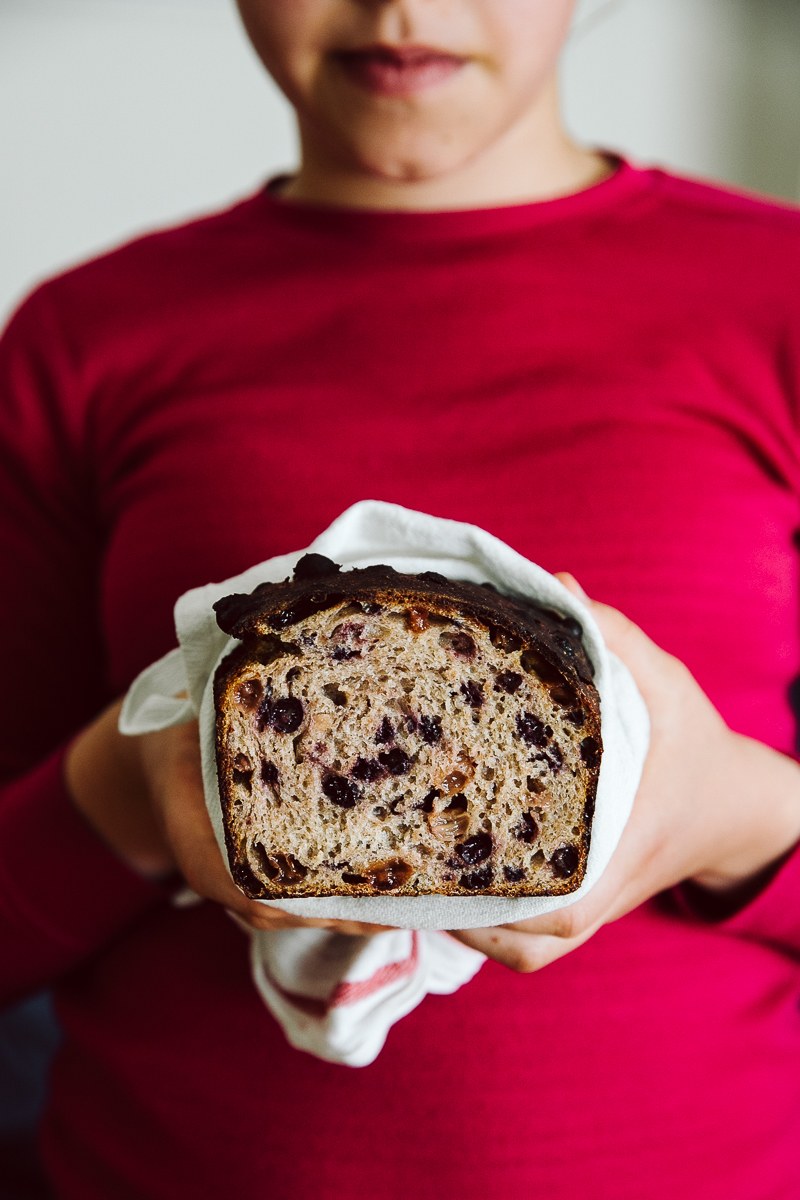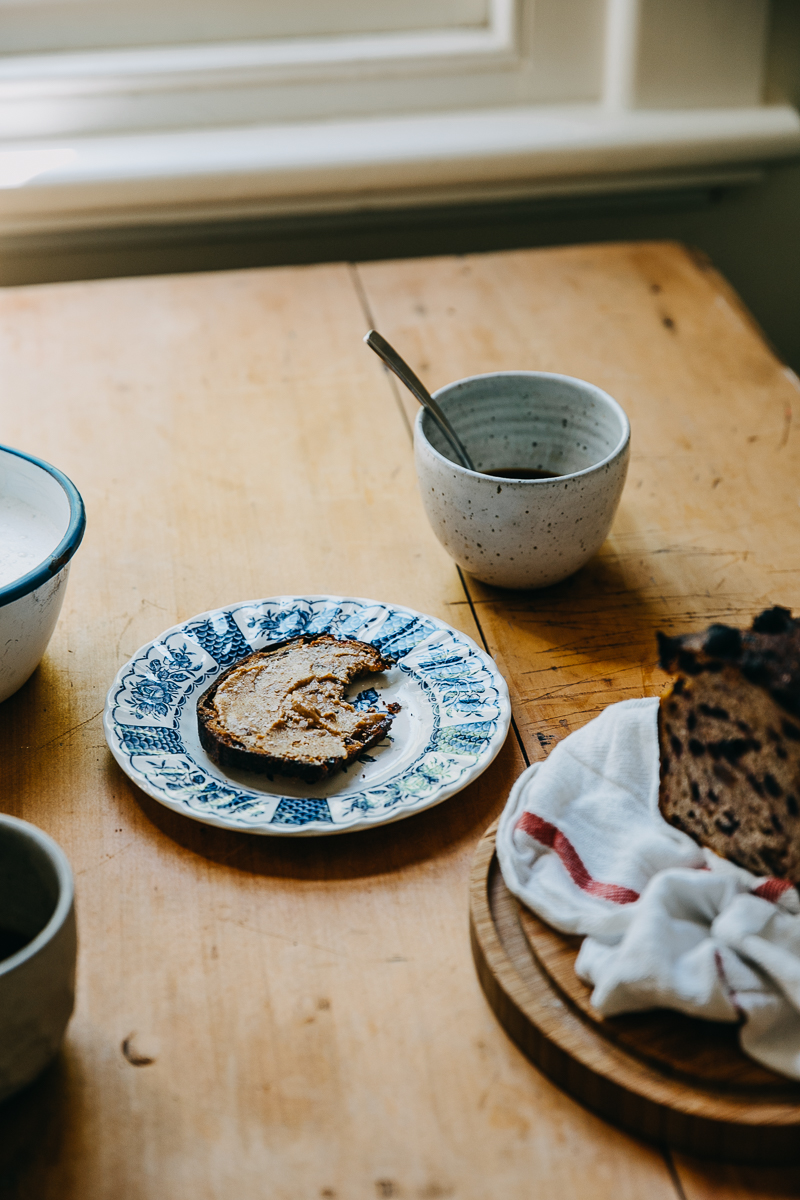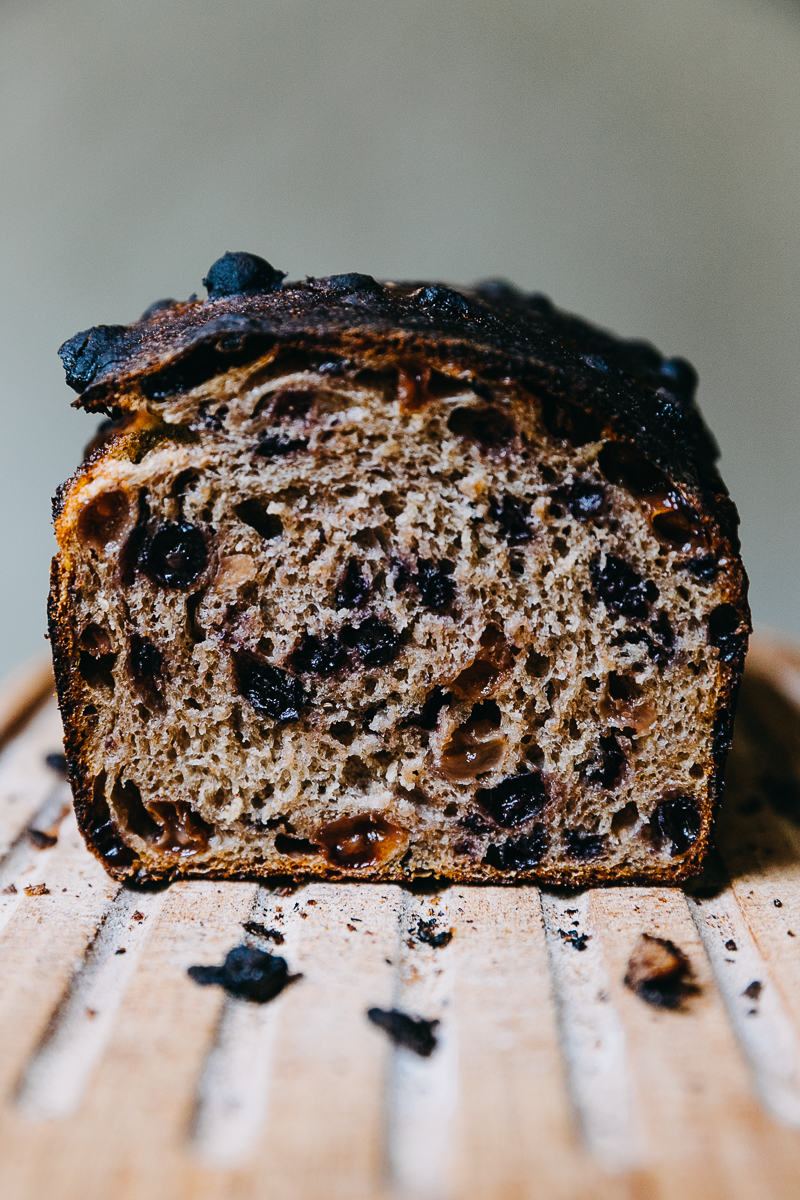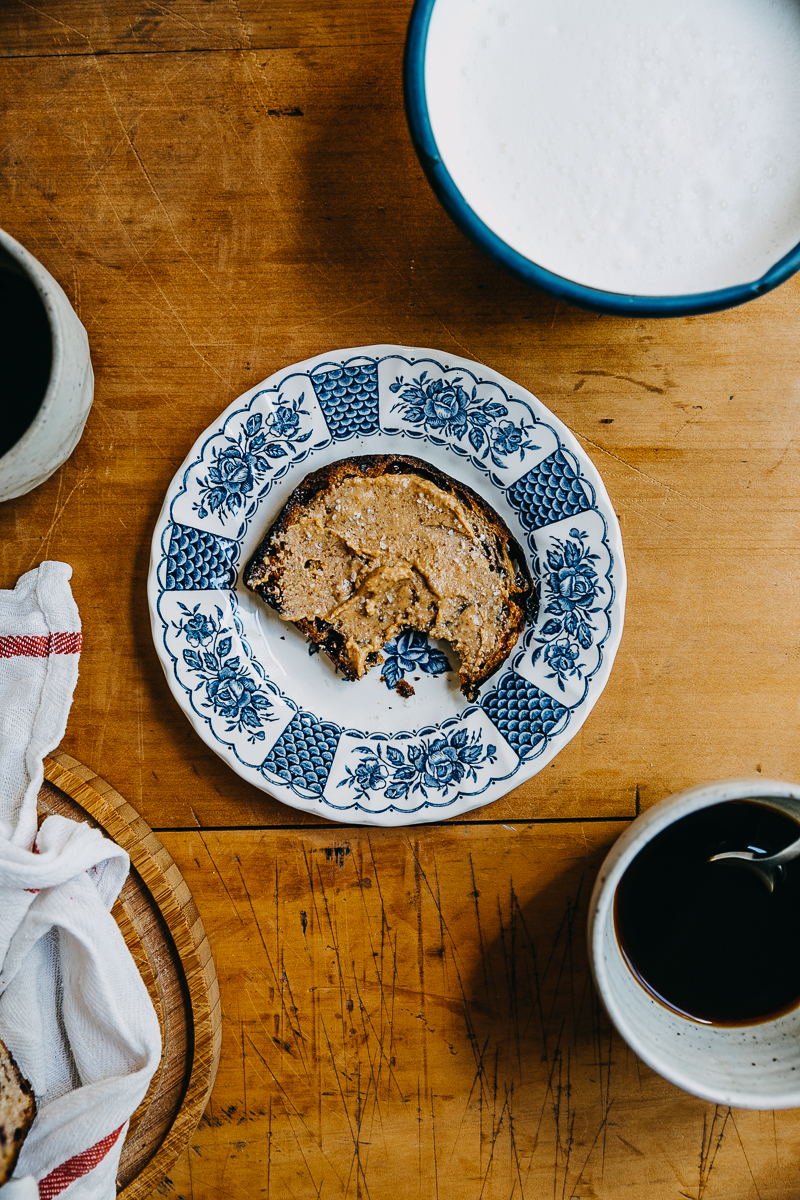Make your own Sourdough Fruit Loaf
March 13, 2020

Afternoon tea is special, and something I am always up for. It’s a chance to regroup and have a quick chat, refresh for the rest of the day and helps life, and the week, feel more relaxed. It’s not every day we can stop for afternoon tea, but I love taking a little break together in the afternoon whenever we can. Sourdough fruit loaf is perfect for afternoon tea when the weather gets cooler and you really want something cosy.
We really love this fruit toast in our house – a hot, buttered slice alongside a cup of tea feels like a total luxury, albeit a really simple one. Inspired by this deep, fruit toast love, this year we’ve started making our own. Let me tell you, it’s worth it – this loaf is a real treat.
Click here if you want to go to straight to the recipe.

Years ago I tried making sourdough and, honestly, I never quite got the hang of it. My bread wasn’t quite as good as bread I could buy which was always my goal – when you put in the effort to make something, you really want it to be good. After a few months of slightly underwhelming loaves (and a midnight interloper breaking into my starter) I lost heart and abandoned the quest. I’ve decided to give it another go. And now that I can make my own fruit bread which is every bit as good as any we can buy, I feel excited. We get to have that special treat whenever we like. The cosy vibes of the house have definitely gone up a notch.
About a month ago, I set out and grew a new starter using organic, wholegrain spelt flour and water. It was bubbling and ready to go in under a week!
I sat down that weekend with a cup of tea and looked through all my bread books (which is always one of my favourite things to do) and compared all the recipes and timelines, trying to find how to bake sourdough in a way that would work for me.
What I realised is that there are a million different ways to make sourdough, so instead of feeling bound to any one way, I read about the signals to look out for from the dough, for when it is ready to bake.
I played with letting it rise on the bench and baking it the same day, and also popping it into the refrigerator and baking it the next. I also read that you can even let an unbaked loaf sit in the refrigerator for a two or three days and bake it later in the week, great for when you’re actually ready for the next loaf of bread. I tried it, and it worked. I never knew baking sourdough could be so flexible.

If I’m having a homely kind of day, I just let the dough rise on the bench, and keep an eye on it for when it’s proved. But when life is busy and I don’t seem to have a moment at all, I make the dough at night and put it in the fridge ready to bake it at a time that suits, which is usually when I’m making dinner the following day, and the oven is already on anyway!
Who says bread needs to be fresh first thing in the morning? Fresh bread at dinner time is very fine and means there’s some ready for tomorrow.
I am still working on it (for baking sourdough is a vast subject with lots possibilities and I have lots of room for improvement) but now instead of feeling restricted I can notice the differences in the dough and make the timing suit me.

Making sourdough can feel like a commitment because it’s a two or three day process, but I assure you most of that time is very hands off – one day might just be mixing a little flour and water together, which you can do while waiting for the kettle to boil. You can take your time working the dough over the course of an evening, then forget about it until tomorrow.
By thinking about the process more simply, and not letting myself get overwhelmed by the steps, I’ve made making sourdough more simple in my mind which has made it more simple in reality.
Sourdough is kind of the ultimate when it comes to bread; the fermentation process makes the bread much easier to digest and get the goodness from. It’s bread you can really sink your teeth into and that will sustain you for a long time; and it is just so much tastier, honestly. Sourdough can fuel your day in a way that ‘regular’ bread just never can.
If you use organic flour (which I highly recommend) you will be supporting beneficial farming practises and can know exactly what you’re eating – which when it’s sourdough is only flour, water and salt. That’s it. This is the basis of this loaf, and of every true sourdough.
If making your own bread feels like all too much, I understand – why not do a little research and turn buying your bread into something you really look forward to? We’re lucky to have a bunch of awesome sourdough bakeries nearby where you can buy bread without a plastic bag in sight, because sourdough just doesn’t need a plastic bag to keep it fresh.
Do good, feel good thought of the week – try to buy your bread without plastic!
Or, if it feels like fun, have a go at making your own.
Find a bakery near you where you can buy a really great loaf of bread, without plastic! You can bring your own bag, or even a tea towel (which is what I use) to wrap your loaf in; or pop it in a brown paper bag, which you can add to your compost at home to increase the carbon content, which every healthy compost needs!
If you don’t have an independent bakery near you, go into your regular bakery and ask them if they will put your usual loaf in your own bag or tea towel. The more of us who ask, the more we can help encourage this easy change.
Shopping for bread is a real treat! Make it an outing and have a coffee and croissant while you’re there, that way grabbing a great loaf of bread is always something to look forward to.

Bread baking skills are awesome, and as long as you have flour and a little salt in the cupboard, plus your starter and water, you will never go hungry. A loaf of sourdough in the house makes for cosy afternoon teas, quick breakfasts and easily filled lunchboxes, all week long.
Here is the recipe for our latest (and always) favourite fruit bread, tweaked slightly from The Tivoli Road Baker, the cookbook from an amazing bakery on the other side of town. By making my own, I can have their bread at home, whenever I like (all without ever getting out of my pyjamas).
I have found this fruit loaf to be a great entry point into making sourdough. It’s a little more cumbersome to handle because of the fruit, but the dough seems to be more forgiving, probably because the fruit helps provide some structure.
The dough rises in the tin overnight, so there’s no need for special equipment. In the morning I check to see if it has almost reached the top of the tin, if not, I leave it be and check on it later in the day. Once it’s about 3/4 filled the tin, it’s good to go!
We love our fruit loaf with pops of orange peel, but for us right now citrus isn’t quite yet in season, so my trick is to include a tablespoon of marmalade during the folding stage, which gives this loaf a special, orangey zing. Fancy.

Sourdough Fruit Loaf
with orange marmalade
adapted from The Tivoli Road Baker by Michael James
For this recipe, you will need an active sourdough starter.
Sourdough is an active, living thing, and will work faster on warm days and slower on cool ones. Keep your eyes open and notice what your dough is doing – for this particular loaf I know it is ready when it has almost risen to the top of the tin. If it’s taking a bit long and you want to hurry it along, pop it somewhere a bit warmer to speed up the process.
Because making this loaf is a two day process, I have broken it up into 4 main active times to make it easier to follow – the morning before you want to bake, the afternoon before you want to bake, the evening before you want to bake and the day of baking.
When it comes to the afternoon part of the process, I like to start this mid to late afternoon, when I’m having a cup of tea. This gives me enough time to autolyse the dough (don’t be scared by the word, it just means giving the flour and water time together to be friends) and then get the folding done while I’m cooking dinner and washing up afterwords. Then I have a little relax, pop the kids to bed, and watch a little TV before I shape the dough and pop it in the tin before I head to bed.
The time when you bake your loaf, on the second day, will depend on how the dough is rising and the temperature in your house. If it’s pretty hot inside, pop the dough in the fridge so the dough isn’t ready before you are! Remember, changing the temperature can help you out – cooling it down slows it down, and putting it somewhere warm (like inside an oven that is turned off, with a bowl of steaming water) will help speed things up. Make the dough work for you, not the other way round! The more you do it, the easier it will be!
I apologise that this recipe is such a long read; have one quick read through before you begin then take it step by step and you will be fine! Be confident, and give it a go. Look for those signals for when the dough is ready to be baked and trust yourself. Go you, you’re about to make sourdough!
The morning of the day before you want to bake your bread
320g dried fruit (we like half currants and half sultanas, but feel free to add chopped figs, dates or apricots or any dried fruit you really like)
100ml recently boiled (hot!) water
1 earl grey tea bag
•
40g sourdough starter
20g bakers flour
20g whole-wheat flour
40g warm water
Soak the dried fruit in the hot water – if you would like to add a little extra flavour to the fruit try adding a cinnamon stick and 2 star anise to the hot water or an earl grey tea bag; I usually remove the spices or tea bag after about 20 minutes and then allow the fruit to keep soaking in the infused water until the afternoon.
Prepare the starter which you will use a portion of this afternoon. Mix 40g of your starter with 20g bakers flour, 20g wholewheat flour and 40g warm water together in a glass jar with a wooden spoon. Set aside somewhere warm to grow throughout the day.
Go and have a great day! See you again this afternoon.
The afternoon of the day before you want to bake your bread
255g bakers flour
45g whole-wheat flour
45g rye flour
25g wholegrain spelt flour
270g warm water
+
70g of that active starter you just made this morning!
7g fine salt
+
1 heaped tablespoon marmalade (optional, but definitely recommended)
the soaked fruit you prepared this morning, drained of excess liquid
+
a loaf tin oiled with a little olive oil
In a large bowl, mix together the flours and warm water until they are thoroughly combined. Cover with a damp cloth and set aside for about half an hour while you have a cup of tea.
Add 70g of the active starter you made this morning, to the flour and water mixture you made half an hour ago. Mix it together by squishing it through your fingers. Once well mixed, sprinkle the salt evenly over the dough and mix it together, squishing it through your fingers again. Cover with a damp cloth and set aside again for another 30 minutes.
Drain the excess liquid from the dried fruit; we are now going to add the fruit and the tablespoon of marmalade to the dough, and use the folding process mix it in. We are going to keep the dough in this same bowl during the entire folding process.
Add the fruit and marmalade to the top of the dough, then using a wet hand, slide your hand under the dough until you reach about the middle, underneath. Gently pull the dough up and out – you don’t want to tear the dough so be gentle and don’t stretch it so far that it tears, and fold it over to the middle of the top. Give it a little press to help it stick. Repeat this on all sides of the dough, until you have folded over all of the dough and the fruit is mostly incorporated – you can do a few more folds if you feel like it didn’t quite get all nicely tucked; this first fold is the most involved while you are mixing the fruit in.
Set the dough aside in the bowl, covered with the damp tea towel again and pop back every half hour or so to give it another fold in the same manner – these next folds will be easier than the first! – until you have folded it four times. After the last fold, let it rest in the bowl covered with the damp tea towel for 2 – 3 hours. Go and have a rest for a bit!
After a few hours, which for me is usually just before I’m ready to go to bed, preshape the dough – which basically means you will perform a bigger version of the fold on the bench top to make the dough tighter. Tip the dough out of the bowl, give it a gentle squish down to squish in any air bubbles and then give the dough a good fold (like you did in the bowl) to form it into a ball again.
Once you have performed a good fold, flip the dough over so the seam is on the bottom, then using your hands or a dough scraper (I like to use a dough scraper with my right hand and cup the side of dough with my left hand) turn the dough in circular motions on the bench top, dusting with just a tiny bit of flour to make it manageable. This dough is stickier than regular sourdough because of the fruit, but having it be a little sticky will help you get it tighter while you are turning it. Keep turning until the ball of dough is nice and taut and sitting up all on it’s own on the bench. Cover with a damp tea towel for 15 – 20 minutes (maybe while you brush your teeth), then you can come back to shape it and pop it in the oiled tin.
Now you want to make your loaf (batard) shape. Flip the dough over so the seam is on the top, then gently stretch it out so it is a large rectangle. Grab the top two corners and fold them into the middle so it now has a triangle shape at the top. Grab the tip of the triangle and start rolling it towards you, keeping it as tight as you can, so you end up making a big cylinder shape. Seal the seam into the dough, pinching both sides to keep the dough together.
Click here to watch a video on how to preshape the dough, and then shape it into a batard.
Pop the shaped loaf in to the tin with the seam side down. Cover with a damp tea towel and leave it on the bench top for the night (unless it’s really hot, in which case you can pop it in the refrigerator!) – you have earned your rest! See you in the morning!
The morning you would like to bake your bread.
Good morning! Have a peek at your loaf and see what’s happening. If it’s mostly filled the tin, then it’s ready to bake! If it’s still got a little way to go, pop it somewhere warm (I pop mine beside our stovetop kettle, which warms up when I make my morning cup of tea) and check on it later, when you’re about.
When you think the loaf is ready to bake, preheat your oven to as hot as it will go! Fill the kettle while the oven is preheating.
When the oven is hot, boil the kettle. Pop a deep baking tray into the base of the oven to heat up.
When the kettle has boiled, pop the loaf into the centre of the oven and pour a cup of boiling water into the baking tray that is in the bottom of the oven. Quickly close the oven door to trap the steam in!
Bake for 20 minutes, then reduce the oven temperature to 200°C and bake for another 20 minutes.
Check to see if your loaf is a lovely dark brown! If it is, it’s ready! If not, give it another 5 minutes.
Tip the bread out of the tin and onto a wire rack to cool. Well done you, you made your own sourdough fruit loaf! Time to sit down and enjoy the fruits of your labour.

Leave a note

I love fruit bread so much and have always wanted to try baking it. This turned out beautifully, thanks!!
Yay Kat, I’m so pleased! Sending you lots of love, and fruit toast xxx